 L-R= Kevin Anderson (DOP), Don Parham (Director), Neil Angwin (Art Director) Sovereign Hill
L-R= Kevin Anderson (DOP), Don Parham (Director), Neil Angwin (Art Director) Sovereign Hill
RIOT OR REVOLUTION - notes
DIRECTOR’S STATEMENT – DON PARHAM
Structural And Stylistic Elements Of The Film
There are very few photographs of Victoria at the time of Eureka. People drew and wrote about their world. This is the window we have chosen to look through to examine the Eureka legend – that is to say, the film is largely constructed around the actual words and pictures that people at the time created in order to record their lives and tell the story of Eureka.
Monologues Using Actual Historical Texts
A major structural element of ‘Riot or Revolution’ is that it tells the story of the Eureka Stockade through the eyes of three main characters – the Governor, Sir Charles Hotham (Brian Lipson), Raffaello Carboni (Barry Kay), an Italian gold digger who became one of the Eureka leaders, and Douglas Huyghue (Tim Robertson), a civil servant in the goldfield’s administration at Ballarat.
Hotham and Carboni were protagonists in the drama while Huyghue was a keen observer from inside the Government Camp (which housed the administration) at Ballarat. Each of these men left us with writings that record their observations and feelings about the events at Eureka. Their eyewitness accounts provided rich primary source material which we used as the text for the monologues spoken direct to camera. Riot or Revolution has assembled a wonderful ensemble cast to bring the characters to life through these colourful monologues.
As the caption at the start of the film says – “the lines spoken by actors in this film are the documented words of the historical characters”. This is history grounded in original texts. It is a very different use of the historical record than a script which only claims to be “based upon” real events or original documents.
Hotham, Carboni and Huyghue provide three contrasting perspectives on the Eureka story. We see things from the government side, the rebel side and, through Huyghue, the detached observer’s point of view. It is a balanced and, in some ways, fresh take on an old story. Other characters help to flesh out the story. There is Celeste de Chabrillan (Julia Zemiro), wife of the French Consul and, of course, the reluctant rebel leader, Peter Lalor (Andrew Larkins).
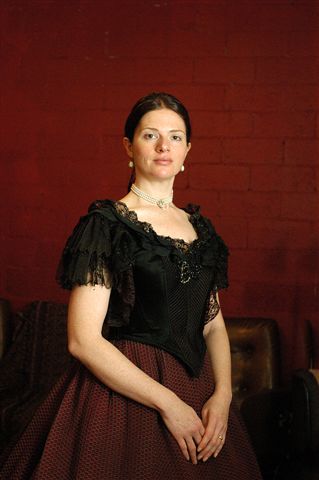 Celeste de Chabrillan, wife of the French Consul (Julia Zemiro)
Celeste de Chabrillan, wife of the French Consul (Julia Zemiro)
Further commentary and insight into the Eureka story comes from interviews with prominent historians, writers and experts on goldrush history, namely, Prof Geoffrey Blainey, Weston Bate, Dr Anne Beggs Sunter and Tom Keneally. The narration is by the actress, Rachael Blake (see cast and interviewee Biogs in Press Kit).
Actors on a Stage with Painted Backdrops
The language our protagonists use in their writings tells us that they saw themselves as actors in a great drama. We reinforced this idea by setting our actors against painted backdrops. It is like they are on a stage. Their performances are deliberately large and theatrical.
Extensive Use of Colonial Art
As we’ve said, photographs are few at the time of Eureka so we have largely gone to the non-photographic record of the period. People made pictures of their world, they used the materials that were available to them, mostly pencil and watercolour. Later some of their pictures went to press and we’ve made use of engravings and lithographs.
There are some magnificent oil paintings that we have used such as the iconic panorama of the Ballarat Goldfields in the summer of 1853-4 by Eugene von Guerard (digital copy included in Press Kit). How wonderful to have such an image that captures the very landscape where Eureka occurred. Indeed, he painted the scene from the point of view of the Government Camp (present day Lydiard St.) looking down on the diggings and with the distinctive shape of Mt Warrenheip “cutting the horizon to the east”. It is exactly the position from which Douglas Huyghue describes the scene on the morning of the battle –
 'Old Ballarat As It Was In The Summer Of 1853-54' by Eugene von Guerard (BFAG)
'Old Ballarat As It Was In The Summer Of 1853-54' by Eugene von Guerard (BFAG)
“The moon had now gone down and the stars were twinkling coldly in the
grey of approaching dawn, while not a breath stirred. Our eyes were strained
eagerly toward the Eureka workings away beyond the valley and immersed
in the shade of Warrenheip, the pyramidal mountain which cut the horizon
to the east, when a single shot was heard, telling us there was a real
collision at last and that the turning point had arrived.”
The colonial artist S T Gill was another favourite. His prolific works are like the photojournalism of the day – they are Cartier-Bresson-esque, wonderfully observed ‘decisive moments’ full of satire, irony and social comment.
After 150 years, Eureka has a proud tradition of people interpreting its many iconic moments in art, and so, we have used some more modern works as well including George Browning’s epic painting of the battle, Eureka 3 December 1854, which now hangs proudly in the Eureka Centre, Ballarat. We also used works by Noel Counihan (On Bakery Hill from the Gold Museum, Ballarat), Norman Lindsay (Peter Lalor, Ballarat Fine Art Gallery) and Peter Graham (Peter Lalor Addressing the Miners before Eureka, Ballarat Fine Art Gallery) .
Aside from the actor monologues, the film doesn’t have many ‘dramatic reconstructions’. Although partly driven by budgetary constraints, it was nevertheless a deliberate choice to rely so heavily on the use of colonial art rather than dramatic reconstructions. It seems so much truer to the spirit of the documentary form to, as far as possible, use the means which people living then, chose to record their world. It is a way of honouring them and the effort they put in to leave us this precious visual record.
Locations filmed
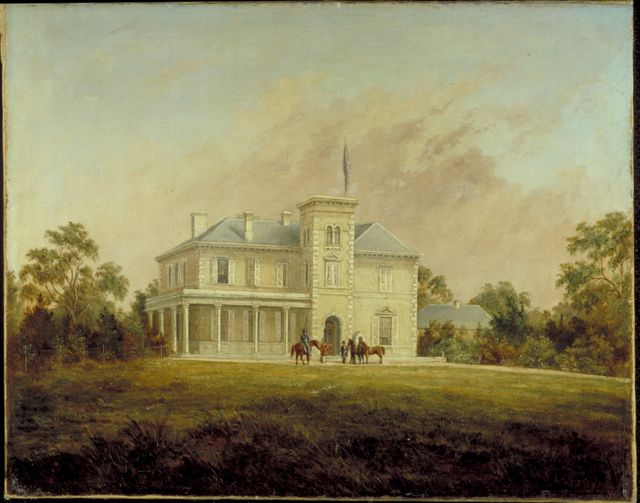 'Toorac' (Governor's house) as it was in 1854 (National Library of Australia)
'Toorac' (Governor's house) as it was in 1854 (National Library of Australia)
The two main locations we used for filming dramatic reconstructions were at Ballarat and ‘Toorac House’ in Melbourne.
‘Toorac’ was an exciting discovery. It was the house provided for Governor Hotham on his arrival and was a much grander house than the one used by the previous Governornor La Trobe. It still stands proudly on a large garden block in Melbourne’s wealthiest suburb, Toorak. The current owners, the Swedish Church in Melbourne, kindly gave us access and it was a very special feeling to film our actor, Brian Lipson, playing Hotham on the very site where the real Hotham walked.
Ballarat is an amazing town, the spirit of the goldrush era is in the air, it’s palpable. It would not have been right to make this doco without filming there. Inevitably, we ended up shooting a number of dramatic reconstructions at Sovereign Hill – it was such a ready made set.
Another wonderful location was the Old Ballarat Cemetery which houses the two original memorials erected for the stockaders and the soldiers killed in the battle. The two memorials stand about 100 metres apart still flying their opposing flags. The words engraved there suggest they are combatants still.
The Eureka memorial says,
“Sacred to the memory of those who fell on the memorable 3rd December 1854
in resisting the unconstitutional proceedings of the Victorian Government”
The soldiers’ memorial says,
“In this place were buried the remains of the British soldiers … who fell
dead or fatally wounded at the Eureka Stockade in brave devotion to duty on
Sunday 3rd December 1854 whilst attacking a band of aggrieved diggers
in arms against what they regarded as a tyrannous administration.”
The location of these memorials becomes the highlight of the closing sequence of the film where we see the caretaker take down the Union Jack and Eureka flag to store them away for the night in his shed. This is his normal daily ritual which we discovered by accident when we were filming. It is one of few ‘observational’ moments in this otherwise highly constructed documentary and provides a fitting visual close as we put the epic story to bed. No-one should read too much into the fact that, as he puts the flags down on the table next to the microwave, the Union Jack sits on top of the Eureka flag.
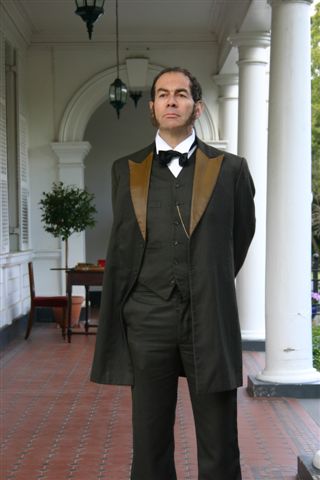 Governor Hotham (Brian Lipson) at 'Toorac'
Governor Hotham (Brian Lipson) at 'Toorac'
This ‘observational’ moment is part of the closing sequence that contains the only other ‘observational’ shots in the film, namely footage showing the way in which the town of Ballarat now acknowledges Eureka. Shots of the Peter Lalor pub and the Eureka Pizza, are followed by the lamp post that has a bit both ways - one sign says ‘Eureka St’ this way, the other says ‘Queen St’ that way. It is a metaphor for a town, indeed a country, that still can’t make up its mind about republicanism.
Finally, ff you’re still a bit puzzled about who “won” at Eureka perhaps we need look no further than the next iconic image in the closing sequence – McDonalds on Bakery Hill!
How It All Began
My wife and I were returning to Melbourne via Ballarat after a relaxing weekend away at Daylesford. We had a couple of hours to kill in Ballarat and, as I was very much in tourist mode, I was flicking through a glossy brochure about Ballarat and thinking “what will we do”? It struck me that Ballarat is really one big goldrush theme park and so, obviously, we should go to one of the many institutions in the town dedicated to its memory, so off we went.
We ended up at the Eureka Centre, built (approximately) on the site of the original stockade. It is an impressive building with a giant rebel flag out front that is visible for miles around. As you enter you are confronted by George Browning’s extraordinary painting of the battle and then, as you weave your way through the museum, you are taken on a thrilling multi-media journey that brings to life the Eureka legend.
As I wandered through the Eureka Centre, the idea for ‘Riot or Revolution’ was born. I had entered as a tourist, but came out as a film-maker, busily scribbling notes to myself on the pad I always carry with me. Three things had struck me about the Eureka story –
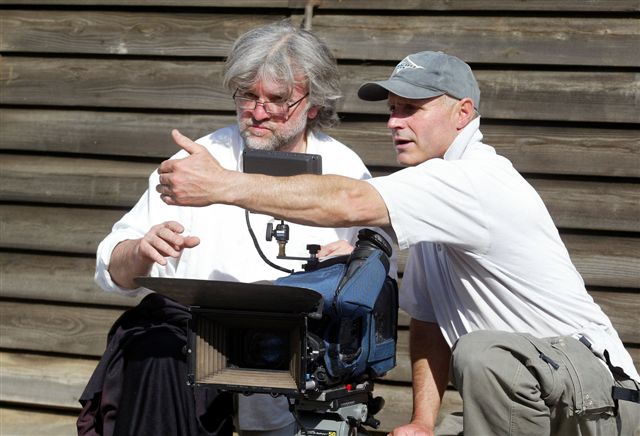 (left, right) Don Parham (Director), Malcolm Crook (2nd camera) - shoot at Sovereign Hill, Ballarat
(left, right) Don Parham (Director), Malcolm Crook (2nd camera) - shoot at Sovereign Hill, Ballarat
- What a ripper yarn
- What a great cast of characters
- How intriguing are the politics of it all
When I got back to Melbourne there were other projects I was working on, and so, the notes I’d written to myself were chucked in the ideas file. Periodically, I kept reminding myself “don’t forget about Eureka, don’t let it fall off your radar, do something, pitch it to somebody”. A few months after the visit to Ballarat I forced myself to sit down with the objective of writing 2-3 pages on the idea. As soon as I started opening a few books on the subject my fascination with the story was reignited. I hardly got up from my desk for a month. Before I noticed, I had written 30 pages which I sent to the ABC to see if they were interested. They were.
As I started to look more closely at the Eureka legend, there were two aspects of the way the story was usually told that perplexed me –
- Why was there so little information about such a central character as Sir Charles Hotham, the Governor at the time?
- Why did such a big story as Eureka seem to always begin with a description of what sounded to me like an irrelevant bar room brawl between a couple of drunk diggers (Scobie and Martin) and a suss publican (Bentley)?
It kept nagging at me – why so little information about Hotham? He was, after all, universally portrayed as an autocratic tyrant who caused the Eureka catastrophe. In one exhibit, I discovered only one small quote by Hotham. He said –
“Tell the diggers from me, and tell them carefully, that this commission
will inquire into everything and everybody, high and low, rich and poor,
and you have only to come forward and state your grievances,
and in what relates to me, they shall be redressed.”
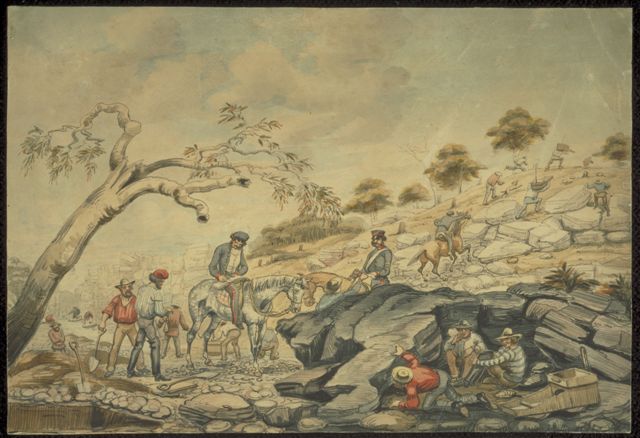 The infamous 'digger hunts' (National Library of Australia)
The infamous 'digger hunts' (National Library of Australia)
Well, this just made me curious to find out more about the context of this quote and more about this man. These didn’t sound like the words of a tyrant to me. And they opened up a whole line of inquiry in my mind, namely, that there must have been an opportunity for negotiation between the government and the rebels, perhaps even an opportunity for Eureka to have been avoided. I wanted to know more.
As for the second problem of the Eureka story always starting with a drunken incident that had turned nasty, I felt I needed to find where the bigger Eureka story really starts. My research soon revealed that this “pub brawl” was of course significant, indeed it lead to an incident that some refer to as “the spark that lit Eureka” where an angry mob of diggers burnt down Bentley’s hotel. I could see that this riot was the first time the aggrieved diggers at Ballarat had used physical force, and they won. As a result the rebel leader, Carboni, wrote in his book (and says in the film) – “The diggers are lords and masters of Ballarat!”
Nevertheless, I couldn’t help thinking that a pub brawl, albeit one that ended in the tragic death of a digger, seemed an odd place to begin such a big and complicated story. There were so many other questions that needed to be answered to put Eureka into its proper context – issues around the nature and impact of the goldrush on this young colony, the tax and revenue regimes, the constitutional arrangements … and so on. As I fleshed out some of these things in the film it is not surprising, I suppose, that the Bentley Incident now appears about half way through the film. I strongly feel all this background is necessary to get us to that point in the story.
Finding the Characters
In the early stages of writing ‘Riot or Revolution’ I thought the biggest challenge would be to find the right balance of characters through which we could tell the story. I came across three wonderful books at just the right time. These books helped me to find the three main characters around whom the film could be constructed – Raffaello Carboni, Douglas Huyghue and Governor Hotham.
The first book is widely known – it is Raffaello Carboni’s own colourful eyewitness account of Eureka. It has the wonderful title, ‘The Eureka Stockade: The Consequence of Some Pirates Wanting on Quarter-Deck a Rebellion’. It was so easy to picture Carboni sitting in his tent on the goldfields, tumbler of wine at his side, writing his rollicking account. His writing is so florid, so passionate, so Italian. The words leap off the page. It was through reading Carboni’s book that I got the idea of doing the monologues, of getting actors to speak these words to camera rather than as voice-overs. This was a critical moment in the development of Riot or Revolution.
The second book was not so well known. It is called “Massacre at Eureka, The Untold Story” by Bob O’Brien and I picked up a copy at the Eureka Centre in Ballarat. In the book, Bob had published, for the first time, an eyewitness account by Douglas Huyghue, a civil servant working in the Goldfields administration at Ballarat. Huyghue’s account was such an instant joy to read that I immediately knew I had my second character. He was on the ground during Eureka but wrote as a detached observer. He worked for the government but his sympathies were often for the rebels. He provided a perfect alternative lens through which to view the story.
 Mounted policeman pursues digger (shot at Sovereign Hill, Ballarat)
Mounted policeman pursues digger (shot at Sovereign Hill, Ballarat)
The texts of Carboni and Huyghue are such an interesting contrast. Although written from opposite sides of the political fence, they are both written by men of learning and literary capacity.
Huyghue writes with the detachment of a learned observer looking on, with sorrowful heart, at human folly. How fortunate we are that he took the trouble, over many years, to collect his thoughts. He first drafted his manuscript in Ballarat in November, 1857 - three years after the events. He then seems to have locked away his treasure for over twenty years, only coming back to revise it late in life (between 1879-84). Then it was put away again and forgotten until, in 1928, a family descendant discovered the document and handed it over to the Mitchell Library.
Carboni was an educated Italian who could speak several languages. Before he came to Australia he had fought with Garibaldi's nationalist forces in Italy but had fled the counter-revolutionary armies of the French and Austrians. In stark contrast to the apparent shyness of Huyghue about his manuscript, the flamboyant Carboni had an eye for commerce. He finished his account in the year following Eureka and was out on the goldfields personally flogging his book at the first anniversary of the battle.
Huyghue and Carboni are two very different personalities who found themselves on opposite sides of the barricades in an extraordinary moment in our history. Their accounts are considered to be historically reliable if, at times, a little idiosyncratic. This latter quality, of course, is what makes their storytelling so fresh and vivid. And the contrast of their personalities and literary styles works a treat.
Compare, for example, how Carboni describes the scene at Bakery Hill on 30 November 1854 - that fateful day when the rebels raised their flag -
“A universal well rounded AMEN, was the determined reply; some five hundred
right hands stretched towards our flag. The earnestness of so many faces of all kinds of shape and colour; the motley heads of all sorts of size and hair; the shagginess of so many beards of all lengths and thicknesses; the vividness of double the number of eyes electrified by the magnetism of the southern cross; was one of those grand sights, such as are recorded only in the history of the Crusaders in Palestine."
In contrast, Huyghue, displays a drollness in the style of that other famous civil servant, Humphrey (of Yes Minister fame). Indeed one of my favourite lines of all time from Humphrey was when he warned his Minister about the nature of “gratitude” in politics –
"Gratitude Minister is just the lively expectation of favours to come".
These sentiments are echoed by Huyghue when he describes the remarkable scene of the rebels' leader, Peter Lalor, strolling down the streets of Ballarat as a new member of the Victorian Legislative Council -
"It was like the incongruity of a dream to see one on whom only a few months back a price was set
now sauntering quietly along the streets with all the aplomb of a senator, conspicuous by his empty sleeve.
And to mark how the fussy politicians of the hour plied him with insidious doses of the
'aura popularis' impelled by a patriotic sense of favours in reserve."
And then there was Hotham – I knew I wanted to make Hotham the third voice but it was only when I came across a book by Dr Shirley Roberts called “Charles Hotham: A Biography” first published in 1985 by Melbourne University Press, that I knew he would work. This wonderfully well researched book brought Hotham to life for me. It provided so many important details about his life before and after his appointment as Governor of Victoria.
I’d been scouring his official despatches to the Colonial Office (available through the Public Record Office Victoria) for the texts that would bring his character to life and I had found some great stuff there. I was ecstatic when I found, for example, the despatch where he wrote to his masters back in London –
“The aspect of affairs now became serious – the disaffected miners formed themselves into corps, elected their leaders,
and commenced drilling; they possessed themselves of all the arms and ammunition which were within their reach. All cause for doubt
as to their real intention from this moment disappeared. A riot was rapidly growing into a revolution.”
You can imagine my excitement at stumbling across this statement given that, based on my other research of Eureka, I had already decided on the title of “Riot or Revolution” for the film. It was a “Eureka” moment for me. The project was now starting to acquire a ‘meant to be’ sort of feeling about it.
But it was the details about the man revealed in Shirley Roberts book, the insights into his character from letters and speeches, that really made him human. At last I knew there was enough primary source material for the monologues that would make Hotham a more three dimensional character, not just the caricature of a big bad tyrant that was the norm in most Eureka narratives I had seen.
At the end of the day, I am deeply indebted to both Bob O’Brien and Shirley Roberts. Finding Douglas Huyghue in Bob O’Brien’s book changed the trajectory of the film. The wonderful primary source texts I now had for Carboni, Huyghue and Hotham would be a more than sufficient foundation on which I could construct the film.
What Pictures Would Be on the Screen?
There remained one major dilemma for the film - given that Eureka largely pre-dates photography, and my budget would not be large enough for endless dramatic reconstructions, what pictures would be on the screen? I soon realised there was an alternative - an incredibly rich historical record in pictures of another kind. Scouring the National Library, various state libraries, the Ballarat galleries and museums, I unearthed great treasures of colonial art from the period. It seemed the perfect marriage – I’d found the ‘text gems’, now I had found the ‘visual gems’.
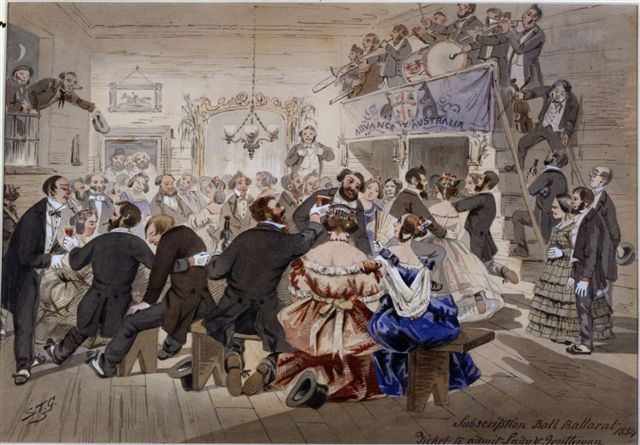 'Subscription Ball, Ballarat' by S T Gill (Ballarat Fine Art Gallery)
'Subscription Ball, Ballarat' by S T Gill (Ballarat Fine Art Gallery)
The colonial artist S T Gill quickly became a favourite and I ended up using so many of his images that I felt the least I could do was thank him in the credits. His works are like photojournalism at its best, wonderfully observed moments full of satire, irony and social comment. Time and time again his pictures seemed to magically complement things I was trying to say in the narration.
There’s another, more personal reason why I chose to make such extensive use of these “primary source” pictures – it was because of the memory of reading books at bedtime to my children. I have the fondest memories of reading bedtime stories to my three daughters when they were young. They were all in the same room and they would lie in their beds as I read. It was my custom to read a page and then turn the book around so they could see the pictures. I can remember the anticipation with which they would eagerly await seeing the next picture. I’d sit in the middle of the room to read the story and then I would get up and take the book over to each child so they could see it in close up. I would hold the book in front of them for a minute or more and watch their faces as their eyes scanned every square inch of the pictures. They were absorbed, enchanted, full of wonder and imagination and learning. To see the way they entered that world through those pictures was something I’ll never forget.
I would like to think that we can capture something of that as we look at the wonderful historic pictures in this film.
BIOGS – CAST & EXPERT INTERVIEWS
Brian Lipson (Governor Hotham)
Brian Lipson is an accomplished performer whose impressive career encompasses film, theatre and television in both his native UK, and Australia. His film credits include the acclaimed films “Howards End” and “Charlie Chaplin”,and closer to home the soon to be released “The Book of Revelation”. His theatre work has seen him perform all over the world for companies such as the Royal National Theatre Company in London, and in Australia was nominated for a Green Room Award for Best Male Actor in a Featured Role for “Hotel Sorrento” in 1998. He has also appeared in guest roles for Australian television programs such as “MDA”, “Blue Heelers” and “The Secret Life of Us” among many others.
Brian is currently performing with Pamela Rabe in ‘Berggasse 19 – The Apartments of Sigmund Freud’ as part of the 2005 Melbourne International Arts Festival. Brian also wrote and directed this piece.
Barry Kay (Raffaello Carboni)
Barry graduated from the Victorian College of the Arts, Drama School in 1988. Since then he has worked predominantly in live performance with theatre companies such as the Murray River Performing Group, Back to Back, Zootango, Salamanca Theatre, Terrapin Puppet Theatre and the Melbourne Theatre Company. Since 1998 he has worked at the Sovereign Hill outdoor museum where he is Interpretive Theatre Manager. Barry’s theatre credits include Cyrano de Bergerac, Twelfth Night, and The Crucible, among many others.
Tim Robertson (Douglas Huyghue)
Tim Robertson is a veteran of the Australian film and television industry, with a career spanning several decades. He has appeared in such Australian movie classics as “The Cars That Ate Paris”, “The Big Steal”, and “The Chant of Jimmie Blacksmith” and in television he has over 50 credits to his name, including “The Sullivans”, “Bellbird”, “Chances”, and “Blue Heelers” among many others.
Julia Zemiro (Celeste de Chabrillan)
After graduating from the VCA, Julia Zemiro toured nationally with Actors at Work for the BELL SHAKESPEARE COMPANY for 2years.During this time, she also became a regular panelist and debater for GOOD NEWS WEEK. As a writer/perfomer on TOTALLY FULL FRONTAL, she played over 20 characters during 2 seasons. Through Tropfest, she has won Best Actress twice for THE EXTRA and MUFFLED LOVE. She has appeared on stage in TRUE ADVENTURES OF A SOUL LOST AT SEA, MACBETH (Green Room Awards nomination Fringe- best actress for both productions) SPONTANEOUS BROADWAY (Burberry Productions) and EUROBEAT THE EUROVISION MUSICAL (Melbourne International Comedy festival.) Julia has been improvising since 1986 in Sydney and Melbourne. Currently she is the host of ROCKWIZ for SBS.
Andrew Larkins (Peter Lalor)
Andrew Larkins is a graduate of the Victorian College of the Arts and has been working as a professional actor since 1985. His credits include film, radio and theatre performances as well as stints on most of the Melbourne based television productions over the last 20 years. A qualified English and drama teacher he also works as a historical interpreter at the Sovereign Hill Outdoor Museum and runs a corporate entertainment company.
Rachael Blake (Narrator)
Rachael Blake is a multi-award winning actress and renowned voice over artist. She is an AFI and Logie award winner for Most Outstanding Actress for her work on ABC TV’s “Wildside”, and in film she won the AFI award in 2001 for Best Supporting Actress for her role in the multi award winning feature “Lantana”. Her other film credits include “Perfect Strangers”, and “Tom White” and the soon to be released US feature "Derailed."
Rachael’s voiceover work has included narration for the 4 part ABC Natural History series “Eye of The Storm”, as well as station promos for ABC TV and SBS Television and many other documentaries.
 Rebel in stockade (shot at Sovereign Hill, Ballarat)
Rebel in stockade (shot at Sovereign Hill, Ballarat)
Professor Geoffrey Blainey
Professor Geoffrey Blainey is one of Australia’s foremost historical authorities. He was the Professor of Economic History and History at the University of Melbourne between 1968 and 1988 and has chaired the Australia Council. He has published over 30 full length historical books including his famous titles “A Short History of the World”, “The Tyranny of Distance", and "Triumph of The Nomads."
Tom Keneally
Tom Kenneally is one of Australia's and the world's most successful writers, having been nominated three times for the Booker prize and winning it once, for "Schindler's Ark". He is the author of more than 40 published works and also has won several other prizes including two Miles Franklin Awards, a Logie Award, an AFI award and the Critics Circle Award for his screenplays. In 1983 he was also presented with an Order of Australia for his services to Literature. Some of Keneally's books include "Jacko", "The Chant of Jimmy Blacksmith" and "Towards Amsara".
Dr. Anne Beggs Sunter
Dr. Anne Beggs Sunter is a lecturer in Australian History and Heritage in the School of Behavioural and Social Sciences and Humanities at the University of Ballarat, Victoria, Australia. Her particular research interest relates to Victorian goldfields history and she completed her Ph D in History at Melbourne University on the topic of the Contested Memories of the Eureka Stockade. She is a Board Member of the Ballarat Fine Art Gallery and Secretary of the Ballarat Fine Art Gallery Association and takes a special interest in the Eureka flag, and artistic representations of Eureka.
She is also Secretary of the Buninyong Historical Society and President of Ballarat Citizens for Thoughtful Development, and is committed to protecting the heritage of the Central Highlands area of Victoria.
Weston Bate
Weston Bate, author and historian, received an OAM in 1997. Weston is one of Australia's best known historians. His 'A History of Brighton' published by Melbourne University Press in 1962 began a period of intense interest in local history throughout Victoria and Australia. He was Professor of Australian Studies at Deakin University, Geelong from 1991 to 1997 and has taught at Melbourne University. He is the Patron of the Prospectors Association of Sovereign Hill and a Life Member of the Ballarat Historical Society. His best known books are probably ‘LUCKY CITY – The First Generation at Ballarat: 1851-1901’ and 'Essential but Unplanned: The Story of Melbourne's Lanes' 1994. He has been the President of the Royal Victorian Historical Society several times. Weston maintains a keenly active interest in all aspects of Australian history.

Crew at studio shoot of monologues
CREDITS
CARDS:
in memory of the
colonial artist
S T Gill
(1818 – 1880)
*
narrator
RACHAEL BLAKE
*
cast
Governor Hotham BRIAN LIPSON
Douglas Huyghue TIM ROBERTSON
Raffaello Carboni BARRY KAY
Celeste de Chabrillan JULIA ZEMIRO
Peter Lalor ANDREW LARKINS
*
interviews
TOM KENEALLY
Prof. GEOFFREY BLAINEY
WESTON BATE
Dr ANNE BEGGS SUNTER
*
director of photography
KEVIN ANDERSON ACS
editor
MARTIN FOX
composer
EVA KING
script editor
DAVID TILEY
CREDIT ROLL:
casting
DINA MANN
sound recordist
CHRIS IZZARD
additional music
JEFF EVANS
LOUISE HILDYARD
art director
NEIL ANGWIN
wardrobe designer
ZED DRAGOJLOVICH
hair/make-up
JOSE PEREZ
BLANCA PEREZ
production manager
MARTINE DARTNELL
2nd camera
MALCOLM CROOK
camera assistant
ANGELO SALAMANCA
armourer/safety supervisor
JOHN FOX
researcher/production assistant
ELISE PARHAM
stills photographers
NEALE DUCKWORTH
DAVID CALLOW
autocue
CARMEL SCHOFIELD
GABRIELLE DEVLIN
makeup (Sydney)
MIMI MCKINNON
safety report
CHRIS PETERS
graphic designer
ROSE DRAPER
on line
DIGITAL PICTURES
Melbourne
telecine colourist
STANLEY LOPUSZANSKI
Digital Pictures, Melbourne
sound post
MICHAEL SLATER
SCOTT FINDLAY
Micsound Studios
camera equipment
VIDEOCRAFT
LEMAC Sydney
post production facilities
OPEN CHANNEL
DIGITAL PICTURES Melbourne
DIGILINE
transcripts
ANNE MARIE ALLAN
release script
MARTINE DARTNELL
character voice-overs
STEWART FAICHNEY
PAUL ROBERTSON
extras
GRANT DANIEL
EDDIE DENOUDEN
MATTHEW DOWLER
MARTIN FOX
MATTHEW “SMILEY” HERBERT
JACLYN HORWELL
CALLAN LEWIS
ELISE PARHAM
SOPHIE PARHAM
STEVE SCULLY
MATTHEW SMITH
JORDAN SULLIVAN
LUKE TONKIN
PHILLIP WILSON
filmed at
Old Ballarat Cemetery
Open Channel Studios, Melbourne
Sovereign Hill, Ballarat
‘Toorac’ House, Melbourne
completion guarantor
JENNY WOODS
Film Finances, Inc
legals
EMMA CORNALL
Holding Redlich
production accountant
ANTHONY NAGLE & Co
insurances
BRIAN HOLLAND
Holland Insurance Brokers Pty Ltd
auditor
G. C. PERRY & Co
special thanks to
ANNE ROWLAND
Ballarat Fine Art Gallery
TIM SULLIVAN
BARRY KAY
Dr. JAN CROGGON
Sovereign Hill, Ballarat
ROGER TRUDGEON
LUKE FLANAGAN
Gold Museum, Ballarat
RON EGEBERG
BOB ALLAN
Eureka Centre, Ballarat
Rev PETER HELLGREN
‘Toorac’ House
Swedish Church in Melbourne
ALISON FRASER
Department of Premier and Cabinet
thanks to
thanks to
Ansonia Hotel, Ballarat
Melbourne Theatre Company
Movie Art
Rose Chong Costume Hire
David Beams
Evelyn Bovell
Dominic Brine
Jennifer Broomhead
Ian Caldwell
Michael Chisholm
Jeremy Constable
Eleanor Goodwin
Patrick Gregory
Pascal Guilloux
Norm Hand
Marie Hardy
Les Harrop
Libby Hart
Martin Lawrence
Pauline Lee
John Lewis
Andy Lindo
Nicholas Mierisch
Andrew Mildenhall
John Moore
Johanna Murray
Adam Reid
Mark Roberts
Dr Shirley Roberts
Jonathan Robinson
Jackie Sarkies
Pam Sheers
Dennis Smith
Daniel Wilksch
Marie Wilson
Phil Wilson
Dr Clare Wright
archival pictures and/or texts
used with permission from
Ballarat Fine Art Gallery
Gold Museum, Ballarat
Sovereign Hill, Ballarat
Eureka Centre, Ballarat
National Library of Australia
The La Trobe Picture, Rare Books
and Newspaper Collections, State Library of Victoria
Parliamentary Library, Parliament of Victoria
Public Record Office Victoria, Australia
National Gallery of Victoria
Mitchell Library, State Library of New South Wales
Allport Library and Museum
of Fine Arts, State Library of Tasmania
University of Melbourne Art Collection
(Courtesy Ian Potter Museum of Art)
Bendigo Art Gallery
Castlemaine Art Gallery & Historical Museum
Melbourne University Press
Five Mile Press
Ballarat Heritage Services
Jeanne Allen
Weston Bate
Michael Cannon
Patricia Clancy
The Estate of Mrs P Counihan
H A & C Glad
Mrs Cynthia Graham
Geoff Hocking
Paddy O’Brien
Dr Shirley Roberts
CARDS:
a project supported through the
Eureka 150 Cultural Program
funded by the Victorian Government
through the Community Support Fund
[logos – Arts Vic, CSF]
*
filmed in Victoria, Australia
with the assistance of Film Victoria’s
MELBOURNE FILM OFFICE
[MFO logo]
*
executive producer
BRIAN Mc. KENZIE
*
writer producer director
DON PARHAM
*
developed with the assistance of
( + logo)
FILM VICTORIA
*
developed and produced in association with
(ABC logo)
THE AUSTRALIAN BROADCASTING CORPORATION
*
financed by
(FFC logo)
FILM FINANCE CORPORATION AUSTRALIA LIMITED
*
© MMV Film Finance Corporation Australia Ltd
and Parham Media Productions Pty Ltd
|